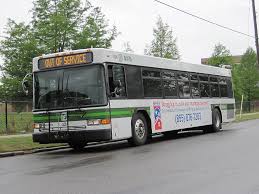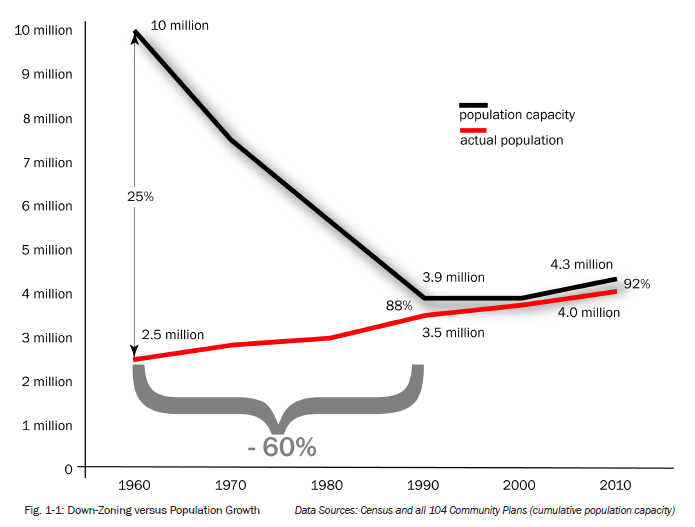Physical Address
304 North Cardinal St.
Dorchester Center, MA 02124
Physical Address
304 North Cardinal St.
Dorchester Center, MA 02124
Last week, Reason.tv (the multimedia outlet of Reason Magazine) published a video about San Francisco’s YIMBY movement. The video describes the decades of underdevelopment in San Francisco as the result of community activism intended to limit the supply of new construction. As a result, San Francisco’s housing market is severely supply-constrained, and outrageously expensive. The problem has gotten so bad that pro-development, “YIMBY” organizations such as SFBARF and Grow San Francisco have sprung up to counter the anti-development forces. It’s great to see Reason taking notice of the YIMBY movement, and we’d love to see more attention paid to urbanism at libertarian sites. Three of us at Market Urbanism attended the first nationwide YIMBY conference in Boulder that the video mentions, and we’ll be sharing our thoughts on the conference soon. (h/t Jake Thomas at the Market Urbanism facebook group)
One common argument against building new housing is that new construction will never reduce housing costs, because the influx of ultra-rich people into high-cost cities creates an insatiable level of demand. I recently found a source of information that may be relevant to this argument: the Wealth Report, which lists the number of high-wealth individuals in a set of world cities, including five American cities (New York, Los Angeles, Chicago, Houston and Miami). In particular, the report lists the number and percentage growth of “ultra high net worth individuals” (UHNWIs), which it defines as those with over $30 million in wealth. It seems to me that if UHNWI growth was related to high housing costs, then the most expensive cities in this group (New York and Los Angeles) would have the highest UNHWI growth. In fact, the number of UHNWIs grew most rapidly in Houston (63 percent) between 2005 and 2015. By contrast, UNHWI growth in the other four cities ranged between 31 and 34 percent. In Canada, UNHWI growth was higher, but roughly equal (ranging between 65 and 70 percent) in Toronto, Vancouver and Montreal- despite the fact that these cities have radically varying housing costs. The median housing unit price in Vancouver tops $1 million, about three times the median price in Montreal. What about UNHWIs as a percentage of city population? New York has 5600 of them in a city of 8.1 million*- just under 700 per 1 million. Low-cost Chicago has 2030 in a city of 2.7 million- about 750 per 1 million. Houston has 1318 in a city of 2.1 million, or around 625 per million. These differences don’t strike me as significant. *I am assuming these people all live in the central city; I am not actually sure this is the case, […]
1. This week at Market Urbanism Brent Gaisford contributed Lack of New Housing On The Westside Is Causing Gentrification Of East And South LA There are a lot of reasons for gentrification, but the lack of new housing on the Westside deserves a lot of the blame in recent years. As we’ve discussed, social and economic changes are pulling new people into LA, many of them young and affluent. A lot of those new people would probably like to live on the Westside, but we aren’t building any places for them to go. 2. Where’s Scott? Scott Beyer flew back Monday from Boulder to Dallas. The most surprising thing he found about the YIMBY conference was how dramatically the fight for land-use deregulation has become a progressive cause. Almost everyone there identified as liberal, and was representing cities like New York, San Francisco, Portland, Los Angeles and Seattle. This growing bipartisan consensus around zoning reform is a subject Scott will soon cover for Forbes. 3. At the Market Urbanism Facebook Group: Jeff Andrade-Fong introduces a new YIMBY org: Tech for Housing Roger Valdez at Forbes: Seattle Mayor’s Affordability Scheme Is More Politics, Less Helpful Change Roger Valdez at Smart Growth Seattle: Lot Suit: City’s Motion to Dismiss Fails, Compares Housing to Porn, Drugs Adam Milsap‘s latest at Forbes: Los Angeles’ New Manufacturing Hub Won’t Generate Innovation Krishan Madan is curious how to respond to arguments that new housing burdens local schools via Nolan Gray: Why the elevator could be the next great disruptive technology by Matthew Yglesias via John Morris: Are artists abandoning NYC? (audio) Jedediah Mackenzie Weeks wants to know what Market Urbanists think of Baltimore‘s Port Covington redevelopment proposal via John Morris: Local Businesses Clash with the City of Portland Over Major Thoroughfare’s Road Diet Bob McGrew wants to hear […]
[Research help for this article was provided by UCLA student Mitchell Boswell] The past 15 years have seen a hell of a lot of gentrification in LA. 15% of our poor neighborhoods have undergone gentrification since the year 2000, and it feels like things have only accelerated since the end of the financial crisis. That’s putting a huge strain on communities across the city, from Boyle Heights to Leimert Park. But before we get into why, let’s get one thing out of the way… Academics love to debate about whether gentrification is good or bad for residents of poor neighborhoods. Maybe we should try listening to what people actually want. Some argue that when a neighborhood gentrifies, more of the existing residents stay in the neighborhood than they otherwise would (one of the many, many hard things about poverty is housing insecurity, so folks tend to move around a lot no matter what), and also tend to be more satisfied after the change. On the other side of the debate are people arguing that as gentrification occurs, the investment and new residents push up rent prices and drive out poor residents who made that community home. It’s not clear who’s right. That all seems pretty academic – it’s an argument between folks who are well-off about whether or not people in poor neighborhoods should be happy. Instead of telling people how they should feel, maybe we should stop and listen, just for a minute, to what they want. And a lot of those people sure as hell don’t seem to want gentrification. The lack of new housing on the Westside is driving gentrification There are a lot of reasons for gentrification, but the lack of new housing on the Westside deserves a lot of the blame in recent years. As […]
1. This week at Market Urbanism Matt Robare summarizes Massachusetts‘ zoning reform: Massachusetts Senate Passes Zoning Reform the bill directs municipalities to allow accessory dwelling units as-of-right in single-family residential districts; permits more as-of-right multifamily housing; reduces the number of votes needed to change zoning from a two-thirds majority to a simple majority; allows development impact fees; eliminates the need for special permits for some types of zoning; provides standards for granting zoning variances; establishes a training program for zoning board members; and lastly, modifies the process of creating a subdivision. Dan Keshet Three Lessons Public Transit Can Learn From Uber When you get in an Uber, you don’t pay fare like you do on a bus. You just start moving. When you reach your destination, you don’t fumble for cash and wait for change like you do in a taxi. You just get out. This may seem like a small detail, but Uber riders frequently cite this convenience as giving the service a magical feeling. Michael Lewyn Are High-Rises More Expensive? But in fact, fairly tall buildings can be pretty cheap where demand is low and/or housing supply is high. For example, in East Cleveland, a low-income suburb of Cleveland, one 24-story building rents one bedroom apartments for as little as $552 per month, despite the fact that the building contains extras such as a pool and a fitness center. 2. Where’s Scott? Scott Beyer is about to join Friday happy hour at the YIMBY Conference in Boulder, CO. His Forbes article this week was about how ‘Mexican Nationals’ Are Transforming San Antonio It isn’t hard to see how the invasion of 100,000 people like Paredes would benefit San Antonio. Foreign conflicts throughout South America have bolstered the real estate market and city coffers in Miami. Conflicts throughout Asia have done the same in North […]

Every form of transportation has some unique considerations. Car drivers worry a great deal about parking near their destination–a consideration bus riders don’t need to think about. But, as transit consultant Jarrett Walker has written about, some considerations are universal. As Uber and Lyft have added carpool services, some people have noted that they can learn from traditional transit: https://twitter.com/jacksmithiv/status/635925087640793088 But what lessons go in the opposite direction? What can transit learn from Uber? LESSON 1: PAYMENT CONVENIENCE MATTERS When you get in an Uber, you don’t pay fare like you do on a bus. You just start moving. When you reach your destination, you don’t fumble for cash and wait for change like you do in a taxi. You just get out. This may seem like a small detail, but Uber riders frequently cite this convenience as giving the service a magical feeling. For the driver, the less time she spends accepting payment, the more time she can spend getting people around. Buses too can use off-board payment systems to relieve passengers of the headache of fumbling for their fare and waiting on 50 other passengers to each find and pay exact change. Typically, passengers get a proof of payment and fare inspectors will check a fraction of rides, much like meter inspectors check a fraction of parking meters. LESSON 2: THERE’S NO SUCH THING AS ENOUGH CUTTING WAIT TIMES With much fanfare, Austin introduced bus services that come every 15 minutes at peak times and every 20 minutes off-peak. For Uber, by contrast, a passenger waiting 15 minutes for service is considered a failure. Downtown pickup frequency was often under 3 minutes and even then, Uber still worked hard to cut wait times down. The company endures a huge amount of negative media and customer sentiment for “surge pricing,” all to make sure that whenever and wherever a passenger requests a car, one will show up in a couple minutes. At $1.25 to $2.50 per ride and […]
One common argument against allowing the construction of taller apartment buildings is that tall buildings cost more to build, and thus are “overwhelmingly occupied by the wealthy.” For example, tall buildings, unlike houses and walk-up buildings, require elevators. But in fact, fairly tall buildings can be pretty cheap where demand is low and/or housing supply is high. For example, in East Cleveland, a low-income suburb of Cleveland, one 24-story building rents one bedroom apartments for as little as $552 per month, despite the fact that the building contains extras such as a pool and a fitness center. This means that (assuming rent should be no more than a quarter of income) someone earning less than $30,000 could afford this building. Even in nicer neighborhoods, older high-rises are not hugely expensive: for example, in midtown Atlanta, the Darlington’s apartments start at just over $700. It could be argued that because these buildings were built decades ago, their costs are not relevant to those of newer buildings. Certainly, newer high-rises are more expensive than older ones- but the same is true for newer walk-ups. To test this proposition, I focused on the outer boroughs of New York, using Zillow.com to focus on buildings built between 2010 and 2016. The cheapest newer apartment in Brooklyn started at $1150 (about $350 more than the cheapest older listing); the cheapest new elevator building started at $1600 (and included a doorman, thus inflating the rent beyond the basic amount caused by elevators). Similarly, in Queens the cheapest newer building rented for $1450 (over $600 more than the cheapest older listing), while the cheapest newer elevator building rented for $1550. In sum, it seems to me that the difference in cost between the cheapest high-rises and the cheapest low-rises, although not nonexistent, are not huge either.
On Thursday, the Massachusetts State Senate voted 23-15 to pass the zoning reform bill, S.2311, after approximately three hours of debate and amendments. 20 of the 63 amendments were adopted, with the rest either defeated or withdrawn. According to the Massachusetts Smart Growth Coalition, the bill directs municipalities to allow accessory dwelling units as-of-right in single-family residential districts; permits more as-of-right multifamily housing; reduces the number of votes needed to change zoning from a two-thirds majority to a simple majority; allows development impact fees; eliminates the need for special permits for some types of zoning; provides standards for granting zoning variances; establishes a training program for zoning board members; and lastly, modifies the process of creating a subdivision. One amendment that was defeated, proposed by Sen. William Brownsberger, removed a provision that would have required cities with an inclusionary zoning policy to offer concessions such as density bonuses. A provision from the first Senate version of the bill, S. 122, that would have allowed for consolidated permitting, was not enacted. Unlike past ones, this bill actually has teeth: the as-of-right multifamily provision establishes a minimum density of 8 units per acre for rural communities and 15 for others and if municipalities don’t comply, courts can provide relief. The bill was passed despite last-minute attempts to derail it by Sen. Bruce Tarr (R-Essex and Middlesex), who attempted to have it sent back to the Ways and Means Committee on the grounds that it had no public hearings since last September. This was rejected by the other senators, with Sen. Dan Wolf (D-Barnstable) saying he wished every bill was as fully vetted as S.2311. “We have fully vetted this, we are ready to move,” he said. “We need to update outdated zoning laws,” said Sen. Harriette Chandler (D-Worcester). “To recommit will serve nothing but […]

1. This week at Market Urbanism Shane Phillips points the finger to a major culprit in LA‘s affordability problems: Keep Los Angeles Affordable By Repealing Proposition U Of the 29,000 acres zoned for commercial and industrial uses throughout LA, 70 percent saw their development capacity sliced in half, from a floor-area ratio (FAR) of 3.0 to 1.5. Since the city allows housing to be built in many of these zones, it didn’t just mean less office, retail, and manufacturing space, but fewer homes as well. Emily Washington contributed to New Urbs at The American Conservative: Family-Friendly Cities Start With Schools But where I depart from Schwarz is that public policy, not economic forces or renter preferences, is largely responsible for the lack of children in American cities. Specifically, education policy. 2. Where’s Scott? Scott Beyer took a writing break this week to wander around Texas, visiting the towns of Cuero, Victoria, Corpus Christi, Kingsville, Brownsville, McAllen, and the Mexican border city of Reynosa. He has since returned to Dallas, and will be flying this week to Boulder, CO, for the first annual YIMBY conference. Tickets for the event are still available. 3. At the Market Urbanism Facebook Group Alden Wilner creates a Wikipedia stub for Market Urbanism, Russ Nelson adds to it. We’d love to see the hive mind expand the page! Adam Millsap‘s latest: What The Boom And Bust Of Williston, ND Teaches Us About The Future Of Cities via Jonathan Coppage at New Urbs: Rescue Cities for Families Shanu Athiparambath wrote, Indian Cities Need Private Fire Stations Matt Robare sums up the Massachusetts zoning reform, which passed the Senate Alex Bernstein wants to know the best objective and unbiases books to start reading Asher Meyers suggest the benefit of Universal Basic Income extends to urban issues based on Charles Murray‘s editorial […]

In 1986, a foreshadowing of today’s fight over “neighborhood integrity” was taking place, culminating in November as Los Angeles residents voted 2-to-1 to cut the development potential of thousands of parcels across the city. Of the 29,000 acres zoned for commercial and industrial uses throughout LA, 70 percent saw their development capacity sliced in half, from a floor-area ratio (FAR) of 3.0 to 1.5. Since the city allows housing to be built in many of these zones, it didn’t just mean less office, retail, and manufacturing space, but fewer homes as well. The ballot initiative responsible for these changes was called Proposition U, and it’s the reason that so many commercial corridors in LA are still characterized by 1960s and ’70s-era, single-story, dilapidated strip malls. All those arterial corridors were the ones permanently frozen in time by Prop U. THE PROPOSAL To my knowledge no one has ever assessed exactly how much this instance of “planning by the ballot” actually reduced the residential capacity of Los Angeles. By my very, very rough estimate, I would put the number somewhere on the order of 1 million homes.* But whether the actual number is 1 million, 500K, or over 2 million, the conclusion is the same: If we want to keep Los Angeles affordable for residents at all income levels, we should repeal Proposition U. Repealing Proposition U would achieve several important aims. Since we’re talking about arterial, commercial corridors, the repeal would dramatically increase the supply of transit-oriented housing over the next several decades—something we desperately need at a time of record-low residential vacancy rates if we’re to have any hope of limiting continued rent increases. It would reduce development pressures on existing communities, directing development to underutilized corridors with little to no housing on them, rather than funneling developers into single-family neighborhoods […]